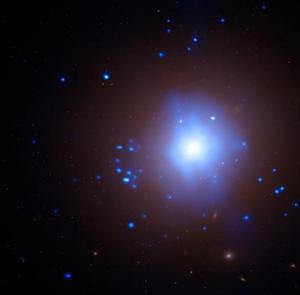
The Haiti earthquake epicenter is marked by the star along the displaced portion (shown in red) of the Enriquillo-Plantain Garden Fault. The 7.0 magnitude quake struck along about one-tenth of the 500-km-long strike-slip fault. The region sits on a complex seismic area made up of numerous faults and plates. The fault lines with small arrows denote a different kind of fault called thrust faults, where one plate dives under another. Strike-slip faults grind past one another. The dotted lines at bottom denote complex seafloor formations.
------------------------------------------------------------------------------------------------------------------------------------------
The magnitude 7.0 earthquake that triggered disastrous destruction and mounting death tolls in Haiti this week occurred in a highly complex tangle of tectonic faults near the intersection of the Caribbean and North American crustal plates, according to a quake expert at the Woods Hole Oceanographic Institution (WHOI) who has studied faults in the region and throughout the world.
Jian Lin, a WHOI senior scientist in geology and geophysics, said that even though the quake was "large but not huge," there were three factors that made it particularly devastating: First, it was centered just 10 miles southwest of the capital city, Port au Prince; second, the quake was shallow -- only about 10-15 kilometers below the land's surface; third, and more importantly, many homes and buildings in the economically poor country were not built to withstand such a force and collapsed or crumbled.
All of these circumstances made the Jan. 12 earthquake a "worst-case scenario," Lin said. Preliminary estimates of the death toll ranged from thousands to hundreds of thousands. "It should be a wake-up call for the entire Caribbean," Lin said.
The quake struck on a 50-60-km stretch of the more than 500-km-long Enriquillo-Plantain Garden Fault, which runs generally east-west through Haiti, to the Dominican Republic to the east and Jamaica to the west.
It is a "strike-slip" fault, according to the U.S. Geological Survey, meaning the plates on either side of the fault line were sliding in opposite directions. In this case, the Caribbean Plate south of the fault line was sliding east and the smaller Gonvave Platelet north of the fault was sliding west.
But most of the time, the earth's plates do not slide smoothly past one another. They stick in one spot for perhaps years or hundreds of years, until enough pressure builds along the fault and the landmasses suddenly jerk forward to relieve the pressure, releasing massive amounts of energy throughout the surrounding area. A similar, more familiar, scenario exists along California's San Andreas Fault.
Such seismic areas "accumulate stresses all the time," says Lin, who has extensively studied a nearby, major fault , the Septentrional Fault, which runs east-west at the northern side of the Hispaniola island that makes up Haiti and Dominican Republic. In 1946, an 8.1 magnitude quake, more than 30 times more powerful than this week's quake, struck near the northeastern corner of the Hispaniola.
Compounding the problem, he says, is that in addition to the Caribbean and North American plates, , a wide zone between the two plates is made up of a patchwork of smaller "block" plates, or "platelets" -- such as the Gonvave Platelet -- that make it difficult to assess the forces in the region and how they interact with one another. "If you live in adjacent areas, such as the Dominican Republic, Jamaica and Puerto Rico, you are surrounded by faults."
Residents of such areas, Lin says, should focus on ways to save their lives and the lives of their families in the event of an earthquake. "The answer lies in basic earthquake education," he says.
Those who can afford it should strengthen the construction and stability of their houses and buildings, he says. But in a place like Haiti, where even the Presidential Palace suffered severe damage, there may be more realistic solutions.
Some residents of earthquake zones know that after the quake's faster, but smaller, primary, or "p" wave hits, there is usually a few-second-to-one-minute wait until a larger, more powerful surface, or "s" wave strikes, Lin says. P waves come first but have smaller amplitudes and are less destructive; S waves, though slower, are larger in amplitude and, hence, more destructive.
"At least make sure you build a strong table somewhere in your house and school," said Lin. When a quake comes, "duck quickly under that table."
Lin said the Haiti quake did not trigger an extreme ocean wave such as a Tsunami, partly because it was large but not huge and was centered under land rather than the sea.
The geologist says that aftershocks, some of them significant, can be expected in the coming days, weeks, months, years, "even tens of years." But now that the stress has been relieved along that 50-60-km portion of the Enriquillo-Plantain Garden Fault, Lin says this particular fault patch should not experience another quake of equal or greater magnitude for perhaps 100 years.
However, the other nine-tenths of that fault and the myriad networks of faults throughout the Caribbean are, definitely, "active."
"A lot of people," Lin says, "forget [earthquakes] quickly and do not take the words of geologists seriously. But if your house is close to an active fault, it is best that you do not forget where you live."
Adapted from materials provided by Woods Hole Oceanographic Institution.












